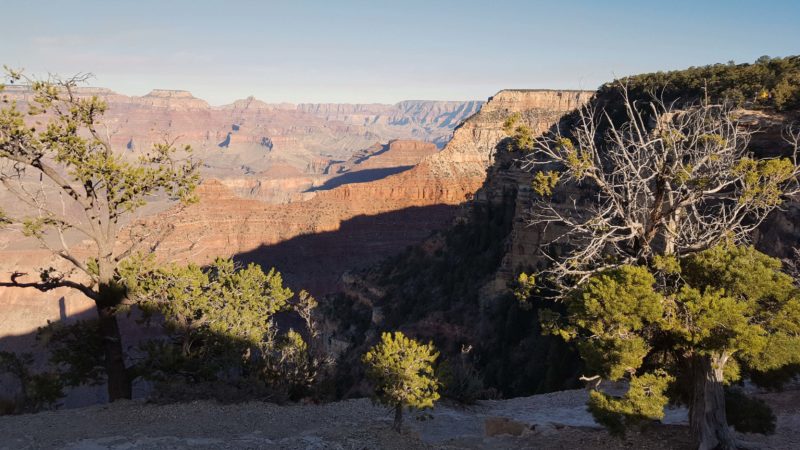Ted and I spent today at the Grand Canyon. Last week we visited Palo Duro Canyon, just south of Amarillo, TX–the second largest canyon in the U.S. It is definitely a distant second to the Grand Canyon. As my brother Tom said, “There are many canyons, but only one is Grand.” It was a beautiful, sunny, calm day. We were at an altitude of about 7,000 feet, so it was cool, but we had jackets, so temperatures in the 50s were no big deal.
We spent most of our time walking on the south Rim Trail. At one point, we saw people on burros at the bottom of the canyon, nearly 6,000 feet below us. A man with binoculars found them and pointed them out. With the naked eye, you could only see them if you knew where to look because, at that distance, they were tiny dots that moved along one of the trails.
One part of the Rim Trail is called the “Trail of Time.” It’s a 2.83-mile-long interpretive geographical timeline, and has received national recognition. (It sounds self-congratulatory for a national park trail to receive national recognition, doesn’t it?) The displays along the trail are well done and include rock samples from each layer of the Canyon walls, set at appropriate markers along the time line. Basically, the trail is a short course in geology. In fact, a high school class was walking the trail for a field trip. Each meter of the trail equals one million years of geologic history, and there are markers set into the trail at every meter to mark the time. The trail begins at “today” and ends at 4,560 million years.

Start walking the Trail of Time here.

Pause here, a million years ago.

Congratulate yourself here before walking the next two billion years of the Grand Canyon’s geology. The Canyon is “only” 6 million years old, but the trail continues for 4,560 million years–the age of the earth’s geological development.
We also listened to an NPS Ranger Talk about the geology of the Canyon. He said that real geologists would hate him for simplifying the development of the Grand Canyon to the word you say when you first see it: DUDE.
D for deposition–the soil deposited in the Grand Canyon that later turned to rock.
U for uplift–the movement of the tectonic plates that raised the Grand Canyon.
D for down–what the river did to the rock: wear it down.
E for erosion–what wind and water have done to the rock.
Why didn’t the Colorado River go around the mountains during the “D” portion of the Canyon’s development (wearing it down)? Because the river had the right of way, so it cut right through them.
Of course, we took a lot of pictures and they all show beautiful (grand) views. Here are a few of our favorites.

I like the color contrasts in this photo. The brown in the sky is smoke from a nearby prescribed burn.

Again, the colors of the different rock layers make this a beautiful place to visit.

This was a very deep/steep area. Of course, depth never shows very well in photos but the rock formations are interesting.

We stayed until the sun was setting. All the colors became more golden and red, and the shadows grew larger.

Another great day together for Ted and me.